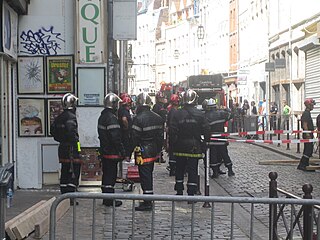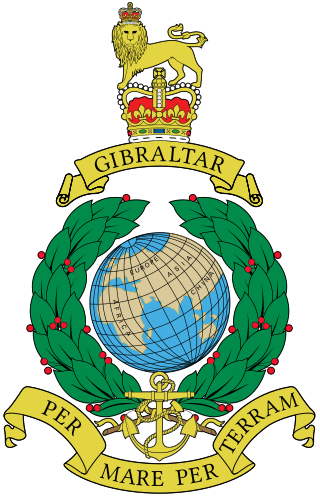Related Research Articles

The Public Force are the military force of Monaco. However, the country has a very limited military capability and depends almost entirely upon its larger neighbour, France, for defence. In total, there are over 250 people employed as military personnel in some form. There is no conscription in Monaco.

A military band is a group of personnel that performs musical duties for military functions, usually for the armed forces. A typical military band consists mostly of wind and percussion instruments. The conductor of a band commonly bears the title of Bandmaster or Music director. Ottoman military bands are thought to be the oldest variety of military marching bands in the world, dating from the 13th century.
The Paris Fire Brigade is a French Army unit which serves as the primary fire and rescue service for Paris, the city's inner suburbs and certain sites of national strategic importance.

The fire service in France is organised into local fire services which mostly cover the Departments of France, with a few exceptions. There are two types of fire service:
BSPP may refer to:

David Nicholas Williams Belle is a French actor, film choreographer and stunt coordinator. He is deemed the founder and leading pioneer of the physical discipline parkour, coining it based on his training and the teachings from his father Raymond Belle.

United States military bands include musical ensembles maintained by the United States Army, United States Marine Corps, United States Navy, United States Air Force, and United States Coast Guard. More broadly, they can also include musical ensembles of other federal and state uniformed services, including the Public Health Service and NOAA Corps, the state defense forces, and the senior military colleges.

The Royal Marines Band Service is the musical wing of the Royal Navy and an independent element of the Royal Marines. It currently consists of five bands plus a training wing – the Royal Marines School of Music at HMS Nelson – and its headquarters is at HMS Excellent, Whale Island, Portsmouth.

A Corps of Drums, sometimes known as a Fife and Drum Corps, Fifes and Drums or simply Drums is an army unit used in several nations. Drummers were originally established in European armies to act as signallers. The major historical distinction between a military band and a corps of drums is that 'drummers' were not employed to play their instruments to entertain or delight, but instead to carry out a utilitarian battlefield role. This role is fulfilled by trumpeters or buglers in the cavalry and the artillery, who traditionally did not form into organised groups in the way that drummers did; therefore, a typical corps of drums would exist in the infantry arm.

A fanfare band, fanfare corps, fanfare battery, fanfare team, horn and drum corps, bugle band, drum and bugle corps, or trumpet and drum band is a military or civilian musical ensemble composed of percussion instruments, bugles, natural horns and natural trumpets. Fanfare bands are the descendants of the old medieval trumpet and drum teams that sounded fanfares on important occasions and are related to drum and bugle corps internationally.

A drum major in the military is the individual leading a military band or a field unit. It is an appointment, not a military rank. Military drum majors utilize a ceremonial mace for giving commands while marching. Many drum majors, particularly American- or British-influenced ones, wear a sash that can carry embroidered badges of their home unit and battle honors; a pair of ceremonial drum sticks are often attached.

Canadian military bands are a group of personnel in the Canadian Armed Forces (CAF) that performs musical duties for military functions. Military bands form a part of the Music Branch of the CAF, composed of six full-time professional Regular Force bands, 15 Regular Force voluntary bands, and 53 part-time reserve force bands. Bands of the Music Branch are often badged with the unit or Canadian Forces base insignia that they support.

The Music of the Foreign Legion, formerly known as the Principal Music of the Foreign Legion is a Military band of the French Foreign Legion.

A police band is a military-style band operated or sponsored by a police force. Police bands provide ceremonial support for civic events, and perform at police observances such as funerals and police academy graduations. Most police bands consists exclusively of professional police officers, while others consist of personnel of law enforcement and other special agencies. Like military bands, their repertoire is mostly composed of ceremonial marching music and honors music.

A mounted band is a military or civilian musical ensemble composed of musician playing their instruments while being mounted on an animal. The instrumentation of these bands are limited, with the musician having to play their instrument, as well as steer the animal to the designated location. Most mounted bands, therefore, use instruments that can easily be held, such as bugles, horns, and Fanfare trumpets. Timpani and glockenspiels are also a common feature, usually located at the head of a band. Although a band that is mounted on any member of the families Equidae and Camelidae are considered to be a mounted band, horses are most commonly used, mostly being employed in military bands in Europe, North and South America, and some parts of Asia.

The Mobile Gendarmerie Music Band is a Military band unit of the Mobile Gendarmerie. It is placed under the authority of the Military governor of Paris. In this capacity, it accompanies ceremonies in the capital for the on the national level. It is a part of the National Gendarmerie and is one of two military bands in the service branch, with the other being the French Republican Guard Band.

The Musique des Troupes de Marine (M-TDM) is a military band in the French Army, attached to the army's naval infantry branch; the Troupes de marine. It contributes to the prestige of many official ceremonies and gives honor to high ranking French personalities. It frequently represents the French Republic abroad in military tattoos and military parades in countries such as the United States, Canada, South Korea, Israel, India, Bulgaria, and Russia. Since 1991, the band has been located at the Camp de Satory in Versailles, Yvelines. Operationally, it is assigned to the Army Music Command.
The Band and Bugles of the Rifles is a military band serving as the regimental band for The Rifles, the sole rifle regiment and the largest in the British Army. It is the senior most of three bands in the regiment and is the only one that is part of the regular army. Uniquely, it employs bugles at its front, a tradition that goes back to the conflicts of the 18th century. Major Séan O’Neill is currently serving as the Director of Music (DOM) of the band and bugles. It is part of the Royal Corps of Army Music.
The Loyal Edmonton Regiment Band (L EDMN R Band), a Canadian Army volunteer brass and reed band that serves as the de facto official military band of the Central and Northern Alberta area and the regimental band of The Loyal Edmonton Regiment (4th Battalion, Princess Patricia's Canadian Light Infantry) in Edmonton, Alberta. Operationally, it's part of the 41 Canadian Brigade Group. The band's force strength is currently at 22 personnel.

The military bands of the United Kingdom are musical units that serve for protocol and ceremonial duties as part of the British Armed Forces. They have been the basis and inspiration for many military bands in the former British Empire and the larger Commonwealth of Nations as well as musical organizations in other countries. Military musical units with British influence include United States military bands, the Japan Ground Self-Defense Force Music Corps and the Military Band of Athens. British military bands are controlled by the military music departments of the three services that compose the armed forces. These include the Royal Marines Band Service, the Royal Corps of Army Music, and the Royal Air Force Music Services. British style brass bands and carnival bands were then and are currently inspired by the British Armed Forces and its brass bands, especially of the Army's regular and reserve formations, as they follow a similar format as it relates to brass and percussion instruments.